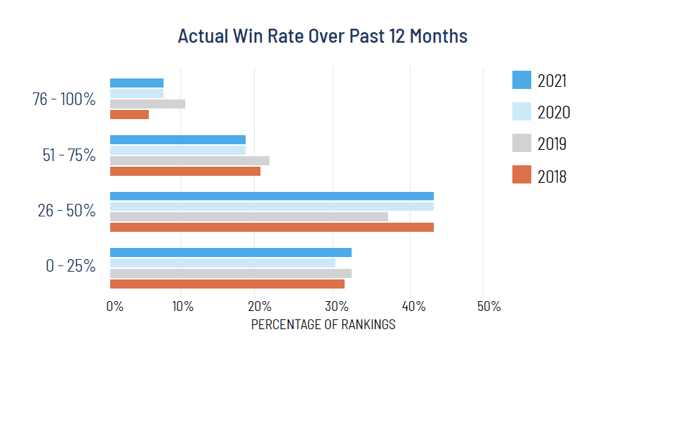Increasing Win Rates with a CRM for Government Contractors and a Robust Capture Process
When win rates are high and competition for projects is limited, a government contracting business might be able to get by managing opportunities with spreadsheets and the lack of a formal capture process.

In today’s world, however, competition for government projects is fierce and keeping pipelines full is challenging. In the 2021 GAUGE Report from Unanet and CohnReznick, the fifth annual GovCon benchmarking and trendspotting report (available for free download here), 75% of the close to 1,500 government contracting firms surveyed reported a win rate of 50% or less, the highest share of respondents reporting a win percentage at or below half since the inception of the report. What’s more, they identified “competition for government contracts” as the main issue keeping them awake at night.
Businesses that are target-smart, on point with their decision-making and most efficient with their capture process from start to finish are winning. Plain and simple, the GovCon firms that excel at maintaining structured business development processes, that do all the big and little things in the capture process well, are the ones that ultimately win more of the types of projects they desire.
As the authors of the 2021 GAUGE Report posit, “the fix [for a sagging win rate] will probably be found in a structured approach to business development in general and pursuit processes in particular.”

Source: 2021 GAUGE Report
Finding that structure can be a massive challenge for firms that rely on a generic, one-size-fits all CRM system, or no CRM system at all. Yet according to findings from the 2021 GAUGE Report, just 55% of firms have a formalized capture or gate process in place for their pursuits. A surprisingly large share — 44% — report using Excel as their pipeline tool, and 30% use no CRM tool at all.
Figures like these suggest there is a golden opportunity for GovCon firms to win more business, more efficiently, simply by modernizing their approach to opportunity management and capture. That winning approach is anchored in six key areas:
- Establishing and sustaining a structured capture process. Firms that follow an organized, repeatable capture process give themselves a much better chance to reliably identify the best-fitting, potentially most profitable opportunities, with the ability to:
- Identify opportunities when they’re still early in the procurement process, giving proposal teams more time to create a winning bid.
- Identify opportunities that fall into the firm’s wheelhouse from a capabilities and expertise standpoint.
- Conduct a SWOT (strengths/weaknesses/opportunities/threats) analysis, a key step in opportunity evaluation.
- Develop and deploy a formalized gate process to evaluate each pursuit at specific points in the opportunity development process. Firms with the highest win rates have the ability to cull “losers” early in the capture process, before they become time and money sinks. The idea is to keep that universe of potential contracts broad early, then down-select as you learn more about the opportunity, the competition, the customer, potential teaming partners and the procurement environment.
Having these processes in place enables a firm to narrow the possibilities to those identified as having the greatest probability of win (Pwin), and that best fit the firm’s capabilities, expertise and performance history. The goal: Expend resources to generate proposals for opportunities with the best Pwin and profit potential.
2. Creating consistently strong proposals. As fiercely competitive as the bidding for many GovCon projects is nowadays, winning new business depends on a firm’s ability to generate superior proposals quickly and efficiently. Once a firm decides to bid for a project and moves to the proposal stage, that’s when robust proposal capabilities integrated within the CRM platform and capture process can really elevate your game, with automation capabilities, templates and other tools that enable firm seller-doers to access the information they need from across departments to create stronger, more accurate proposals, faster. The less time they spend chasing down data from disparate sources, the more they can focus on elevating the proposal by weaving together past performance, key personnel, management approach, proof points and other relevant information to tell a compelling, coherent story about why their firm is the right one for a particular project.
The quality of a proposal can make or break a pursuit. Not only can proposal-creation capabilities help firms put together consistently compelling proposals, they also enable firms to become better at pricing their proposals. Solid insight replaces informed guesswork, preventing a hard-won contract from turning into a losing proposition later.
3. Winning the right kind of business. By far the two most effective ways to uncover more business opportunities, according to GovCons responding to the 2021 GAUGE Report, are the “who you know,” leveraging personal relationships with partners and customers (named by 88%), and the “what you know,” using market intel tools (named by 68%).
A target-rich project environment like today’s demands a target-smart “what you know” approach. When a firm has ready access to market intelligence via sources like GovCon Tribe, GovWin and FedBizOps that are integrated into the framework of a CRM for government contractors and capture process, it can search opportunities and zero in on the ones it most wants in it pipeline, then direct its pursuit energies accordingly keeping bid and proposal costs at a minimum.
4. Growing the firm organically. On the “who you know” side, having a multi-dimensional CRM system capable of calling out opportunities in which someone in your government contracting business (or a well-qualified potential teaming partner) has a strong personal relationship with the contracting entity is a big key to organically filling the project pipeline. Maintaining these contacts and conversations through changes in staff is imperative to a growing business organically over time.
5. Gaining a clear, current understanding of the total pipeline picture. The more real-time, CRM-based insight a firm has into its pipeline — including phantom opportunities, proposals in process and, of course, active projects and resources — the better it can understand and forecast resource deployment, future spend and revenue. Having the ability to easily collect and visualize this data will keep a government contracting business agile and profitable.
6. Managing the capture process with limited effort. Creating a well thought out, robust capture process is only beneficial if the team can easily manage it. No one wants to add another system to their daily tasks. Any new tools or CRM for your government contracting business should live inside the systems already being used on a regular basis by the business development team. This will enable wide adoption, real-time opportunity updates, and a unified team.
With all these elements working in unison, it won’t be long before the business development people at your firm begin to wonder why they ever settled for a subpar CRM and capture process, or no process at all. Growing businesses are moving to these fully integrated capture process tools that are purpose-built for project-based businesses and increasing their win rates with the right business.
Rich Wilkinson is GovCon Industry Director at Unanet and is an expert in government contracting, specializing in compliance. He has spent the last 25 years in executive roles with prominent GovCon accounting software companies. Prior to that he was a controller for Washington, D.C., area government contractors and before that, he served as a contracting officer with the Naval Air Systems Command.